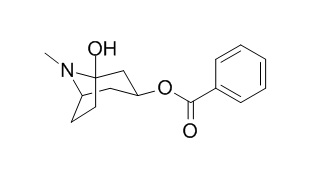1-Hydroxytropacocaine
Reference standards.
Inquire / Order:
manager@chemfaces.com
Technical Inquiries:
service@chemfaces.com
Tel:
+86-27-84237783
Fax:
+86-27-84254680
Address:
1 Building, No. 83, CheCheng Rd., Wuhan Economic and Technological Development Zone, Wuhan, Hubei 430056, PRC
Providing storage is as stated on the product vial and the vial is kept tightly sealed, the product can be stored for up to
24 months(2-8C).
Wherever possible, you should prepare and use solutions on the same day. However, if you need to make up stock solutions in advance, we recommend that you store the solution as aliquots in tightly sealed vials at -20C. Generally, these will be useable for up to two weeks. Before use, and prior to opening the vial we recommend that you allow your product to equilibrate to room temperature for at least 1 hour.
Need more advice on solubility, usage and handling? Please email to: service@chemfaces.com
The packaging of the product may have turned upside down during transportation, resulting in the natural compounds adhering to the neck or cap of the vial. take the vial out of its packaging and gently shake to let the compounds fall to the bottom of the vial. for liquid products, centrifuge at 200-500 RPM to gather the liquid at the bottom of the vial. try to avoid loss or contamination during handling.
Universidade Estadual Paulista2017, 11449
Molecules.2022, 27(7):2116.
Trop J Pharm Res.2023, 22(3):283-288.
Int Immunopharmacol.2021, 101(Pt A):108181.
J Agric Food Chem.2024, 72(42):23183-23195
British Jou. Med.&Med. Research2014, 1802-1811
Plant Physiol.2023, 193(3):1758-1771.
Cells.2023, 12(3):395.
Foods.2024, 13(19):3092.
Korean J Acupunct2020, 37:104-121
Related and Featured Products
Phytochemistry,1994,36(2):357-360.
1-Hydroxytropacocaine: An abundant alkaloid of Erythroxylum novogranatense var. Novogranatense and var. Truxillense[Reference:
WebLink]
A new alkaloid, 1-Hydroxytropacocaine, was isolated from leaves of greenhouse-cultivated Erythroxylum novogranatense var. novogranatense and identified.
METHODS AND RESULTS:
Quantitative levels of this alkaloid in dry leaf were similar to those for cocaine, i.e. 0.3–0.5% w/w. 1-Hydroxytropacocaine was also detected at 0.04–0.07% w/w (relative to dry coca leaf) in greenhouse-cultivated Erythroxylum novogranatense var. truxillense and at similar levels in Erythroxylum novogranatense var. novogranatense, grown at a tropical site other than in South America.
CONCLUSIONS:
The presence of 1-Hydroxytropacocaine was <0.01% w/w (relative to dry coca leaf) in suspected Erythroxylum novogranatense var. novogranatense and Erythroxylum coca var. coca, field-cultivated in Colombia and Bolivia, respectively.



